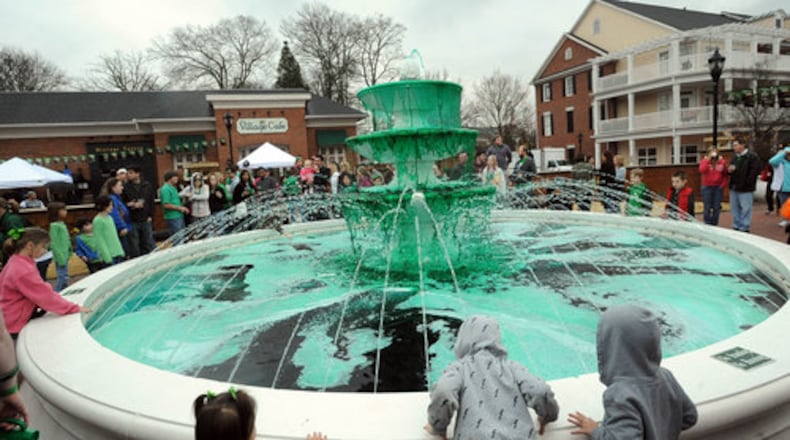Is it Smyrna, Vinings or Sminings? The answer depends on whether you’re a resident, a newcomer who’s not sure where the city limits are, or a real estate developer who wants to add panache to a swanky project. Smyrna Mayor Max Bacon has no such issues: “Oh, I know where Vinings is. But I grew up in Smyrna.”
This updated story originally appeared in the March/April 2014 issue of Living Intown magazine.
Smyrna has held on to its identity as a distinct community, albeit just a bit less chic than its upscale neighbor. But it still reaped the benefits of the 1990s real estate boom, when the southeastern edge of Cobb County became a magnet for residential and commercial developers. Buyers wanted convenience to Atlanta, but not the city and Fulton County taxes. An influx of newcomers quickly filled the gap between the historic hamlet of Vinings on the edge of the Chattahoochee and Smyrna, a municipality that lies farther west. It wasn’t long before real estate wordsmiths were calling the area “Sminings,” blurring the line between the two.
Smyrna’s story resembles that of other small towns on the edge of a major metropolis. It outlived its agricultural past and morphed into a modern bedroom community, but it doggedly found ways to reinvent itself. As a chartered city, it has the services, facilities and amenities that draw new families and retirees alongside folks who have spent their entire lives within its 15 square miles.
One of those native sons is Bacon, who attended the local Campbell High and retired in 2006 as the town’s postmaster. His father was mayor in the 1960s, and Bacon followed in his footsteps in 1985 after serving six years on the City Council. He has been the mayor ever since.
“I’ve seen the transformation from what Smyrna was to what it is today,” says Bacon, 65. “When I was on the City Council in 1980, the population was maybe 20,000; now, it’s around 55,000. ... We’ve had a big growth spurt, but the biggest change for me was going from one extreme of knowing everybody to sometimes not knowing anybody. But that’s okay.”
» RELATED: Stop eating at chain restaurants, Smyrna
History
Smyrna sits on land once owned by the Cherokee Indians. The first churches in the area appeared in the 1830s. By the early 1840s, the tracks of the Western and Atlantic Railroad connecting Chattanooga to Decatur cut through the middle of the settlement, where they remain today. The agricultural community supported cotton mills that were burned during the Civil War. Smyrna was incorporated in 1872.
The first major shift in the local economy came during World War II when the Bell Bomber plant opened nearby in Marietta. The facility produced B-29s for the Army Air Corps and provided employment for many Smyrna residents. After the war years, the Atlanta Road district became a thriving downtown with retail shops, drug and hardware stores, and places for residents to gather.
But the focus began to move beyond the center of town with the 1954 opening of the Belmont Hills Shopping Center, a 50-acre, open-air plaza billed as the largest in the Southeast. Smyrna’s business district declined further when Cumberland Mall arrived in 1973, around the same time a state road-widening project wiped out many of the businesses along the main thoroughfare.
“Belmont Hills was the beginning of the end for downtown,” recalls Bacon. “When they built Cumberland, our downtown died. There were only a few antique stores and a couple places to eat. It was so bad that if you asked somebody to take you to downtown, there were three or four spots you could wind up, but none of them was a real downtown. In 1988, National Geographic did an article on Atlanta, and it mentioned nearby ‘redneck Smyrna.’ And it pretty much looked like a little redneck city.”
That article served as a wake-up call for city officials determined to revitalize Smyrna with an official downtown district. In 1991, the city saw the opening of the Smyrna Market Village, a live-work-play complex off Atlanta Road. Along with retail and office space, townhouses and restaurants, the district included a new library, community center, city hall and greenspace. The project won an Award of Excellence from the Urban Land Institute in 1997 for its design, and today, the Market Village remains the social and commercial center of town.
Community
In the Market Village area, a swanky 25,000-square-foot library draws adults and kids with a variety of programs. Nearby, the community center features two gyms, three racquetball courts, a game room and a walking track. It offers dance and fitness classes, as well as sports leagues. A short walk away is the Wolfe Adult Recreation Center, with a pool, bocce court, exercise rooms and pavilion that cater to the 55-and-older crowd.
According to the city's community profile page, Smyrna boasts a young population. The median household income is $58,545 and per capita income is higher than metro Atlanta. About a third of Smyrna families have incomes above $75,000.
» RELATED: 7 ways to enjoy a rainy day in Cobb County
Attractions
Heritage Park and the Silver Comet Trail. The ruins of the Concord Woolen Mills provide part of the backdrop for this county facility on the Smyrna border. Along with a 105-acre nature preserve, Heritage Park features walking trails, a raised boardwalk over wetlands and access to the Silver Comet Trail, a 61-mile paved path that runs through west Cobb to the Alabama line. The trail's zero-mile marker is in Smyrna at Mavell Road, just off the East-West Connector. silvercometga.com; Cobb county parks.
Concord Covered Bridge. This historic landmark is one of the few covered bridges in the state. Dating back to 1872, the bridge is a narrow span — just 16 feet wide — that stretches almost 132 feet across Nickajack Creek. The site anchors the Concord Covered Bridge Historic Area that was once the site of a mill and a Civil War battle. Today, the bridge sits on a busy stretch of Concord Road that connects Hicks Road with South Cobb Drive. 770-933-7228. concordcoveredbridge.org.
Smyrna Welcome Center. The welcome center and gift shop opened in 1999, but its historical significance lies with the structure itself. It was once part of an 1890s cabin that in 1941 became a destination restaurant called Aunt Fanny's Cabin. It specialized in Southern cuisine until it closed in 1994. 2875 Atlanta Road. 770-805-4277. smyrnahistory.org
Smyrna Museum. Adjacent to the welcome center, a replica of the town's torn-down train station is home to the Smyrna Historical and Genealogical Society. The group keeps a museum that traces local history through photos and artifacts. 2861 Atlanta Road. 770-431-2858. smyrnahistory.org
Brawner Hall. In 1910, this stately, white-columned building on the south end of Smyrna opened as the Brawner Sanitarium. Staff at the 13,000-square-foot facility treated mental illness and alcohol/drug addictions. It was known as Brawner Hospital by the time it closed in the 1990s. After sitting vacant for several years, the building was renovated by the city with offices, meeting rooms and conference space. 3180 Atlanta Road. 678-631-5545. smyrnacity.com.
Jonquil Festival. This festival of food, kids' activities, live entertainment, and arts and crafts vendors from around the country is such a hit that the city hosts it twice a year. Twice a year, the Village Green will turn into a fairground, in late April and then again in late October. 770-423-1330. smyrnacity.com.
Suntrust Park. The new home of the Atlanta Braves is spitting distance from Smyrna, along with The Battery Atlanta, a mixed-use development next door. So, for at least a few years, the newest MLB ballpark is the Jonquil City's neighbor. Locals are justifiably proud but there are likely to be some growing pains, starting with traffic. 1100 Circle 75 Pkwy SE, Atlanta. 404-577-9100. atlanta.braves.mlb.com/atl/ballpark/suntrust-park.
Insider tip:
The nickname "The Jonquil City" is credited to one homeowner's passion for the yellow flowers. Planted in masses on a front lawn that bordered Atlanta Road, jonquils turned the property into a landmark for travelers heading down the main thoroughfare into Smyrna. That property is now called the Taylor-Brawner house and is part of Taylor-Brawner Park. There's still lots of jonquils, and you can get married there.
Insider tip:
The Village Sushi restaurant in the Market Village features a special “Max Bacon roll” — a baconless bite of fried red snapper, avocado and eel sauce.
About the Author
Keep Reading
The Latest
Featured



